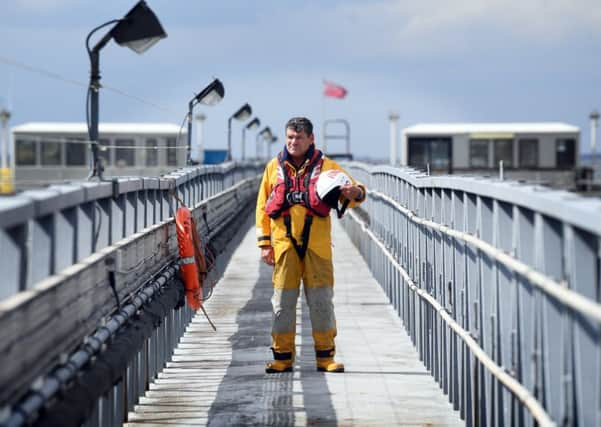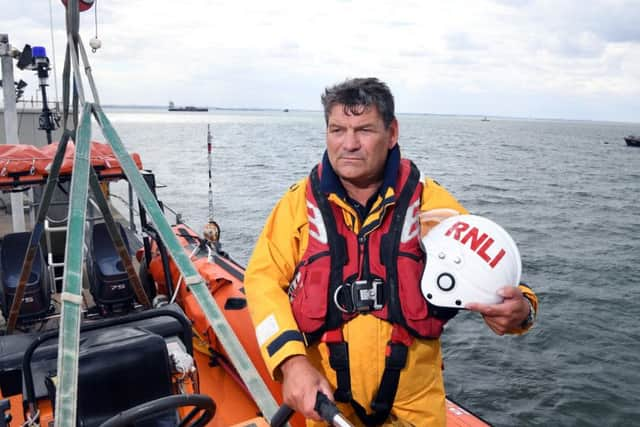Last goodbye for head of Yorkshire's most remote lifeboat station


As the old Land Rover lurches about in the soft sand, the coxswain of Humber Lifeboat Station Dave Steenvoorden beams.
“It’s like driving on ball bearings,” he said.
“But it still has to be one of the best drives to work.”


The tidal surge of 2013 swept away the road and nearly turned Spurn Point into an island
Advertisement
Hide AdAdvertisement
Hide AdJust the year before the RNLI took what turned out to be a sound decision to end the 200-year-old tradition of lifeboatmen living with their families on the fragile peninsula.
Now the crew do six days on, sleeping over in the houses, where he and his wife Karen bought up their twin sons.
Unlike many approaching retirement Mr Steenvoorden, 61, who was awarded the MBE last December for over 30 years distinguished service, is savoring every last minute.
He said: “I could have retired at 55 with a little wodge in the back pocket but I am doing something I passionately believe in - it has never been a job for me.
“I know it is only a matter of time before I go.
Advertisement
Hide AdAdvertisement
Hide Ad“But they (the crew) have said they don’t want me to go until they empty my head.”
This year has been the second quietest in his 28 years on Spurn, with just 18 “shouts”.
Much to his chagrin he has been stuck back at base - he is station manager as well as coxswain - dealing with reams of paperwork, and he has only been out three times in an emergency.
“I am struggling with it,” he admits.
“Someone is playing with my train set.
“I didn’t join the RNLI to push paper.”
One of the biggest changes has been a massive drop in medical evacuations, since the new search and rescue helicopter came in.
Advertisement
Hide AdAdvertisement
Hide Ad“We probably did a dozen or so a year - we didn’t do one last year and not one this year.
“It’s health and safety- they are reluctant to do stretcher transfers off unless it’s an absolute necessity.
“If it’s life threatening the helicopter will take them off.”
Ships too are better regulated with only the odd rogue one and weather forecasting has also improved hugely.
Advertisement
Hide AdAdvertisement
Hide AdAnd sea conditions too are improving - the Beast from the East was the first really bad weather in 15 years.
“It was evil.
“I took the lads out. It was something most of them had never experienced.
“It’s not the size of the waves it’s the big hole you leave behind you - you come off the wave and fall it.
“A Severn Class lifeboat weighs 40 tonnes, if you drive it inaccurately you will get it into the air.
Advertisement
Hide AdAdvertisement
Hide Ad“It is a seriously capable boat in the right hands - or seriously dangerous in the wrong hands.
“That’s why you need an old crusty like me easing the young ones back a bit.”
Mr Steenvoorden, who was a commercial fisherman before joining the RNLI full-time in 1990, is among a dwindling band steeped in the old traditions and language of the sea.
He says he has more superstitions “than the rest of the crew put together” and reels off a list including never saying goodbye to his wife or making his bed (“If you make your bed you are not coming back to it”) and hating green - the colour when “you are getting swamped with lumps of water.”
Advertisement
Hide AdAdvertisement
Hide Ad“The only green on the lifeboat should be the box that the first aid kit is in and the starboard light,” he insists.
He loves “making a difference” - and says life in the real world is “so bloody boring - it’s too cut and thrust.”
For the time being he is busy teaching the crew the “tricks of the trade”, including how “to cut corners safely” through intimate knowledge of the lumps, bumps and “big holes” below the waves.
Established in 1810, Humber is the only lifeboat station with a full-time crew and it has carried out some outstanding rescues during its 200-year history.
The crews have been awarded 33 medals for gallantry.
Advertisement
Hide AdAdvertisement
Hide AdThe Humber Lifeboat station stands on the extreme tip of Spurn Point, the most southerly fragment of Yorkshire, where the fast flowing Humber unites with the turbulent North Sea.
Asked what he recalls over his long career, it is the medical emergencies that come to mind - like the one when they took someone who was ill off a North Sea ferry and his mates gathered around and gave the crew a round of applause.
He said: “It’s little things like that which stick in my mind - more than fighting a gale.
“People ask me what makes a good coxswain.
“There’s good communications and leadership.
“Two is know your boat, three is know your crew, four know yourself and five - know what you can get away with.
“That’s the stuff I am trying to teach - know yourself.
“What you are capable of is what most people overestimate - they overestimate their own abilities.”